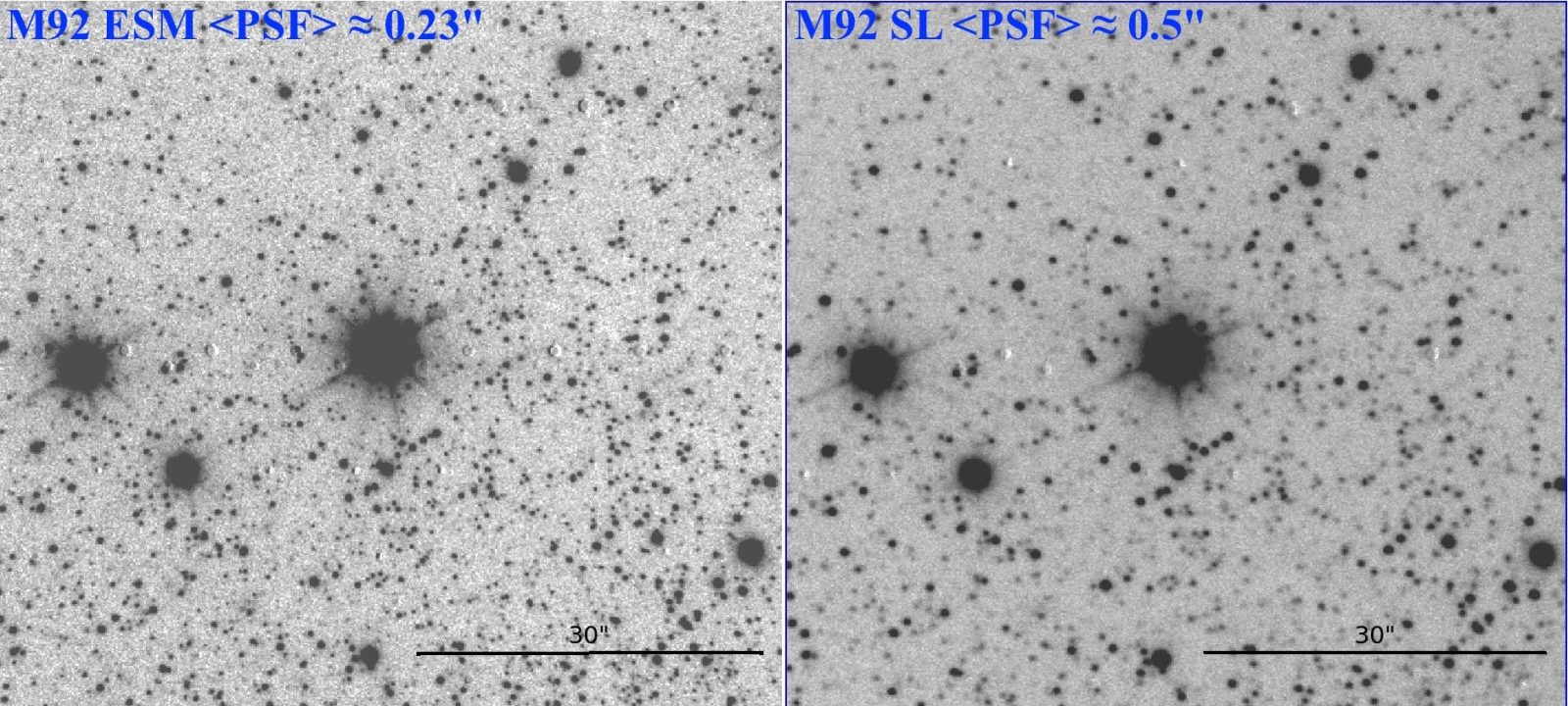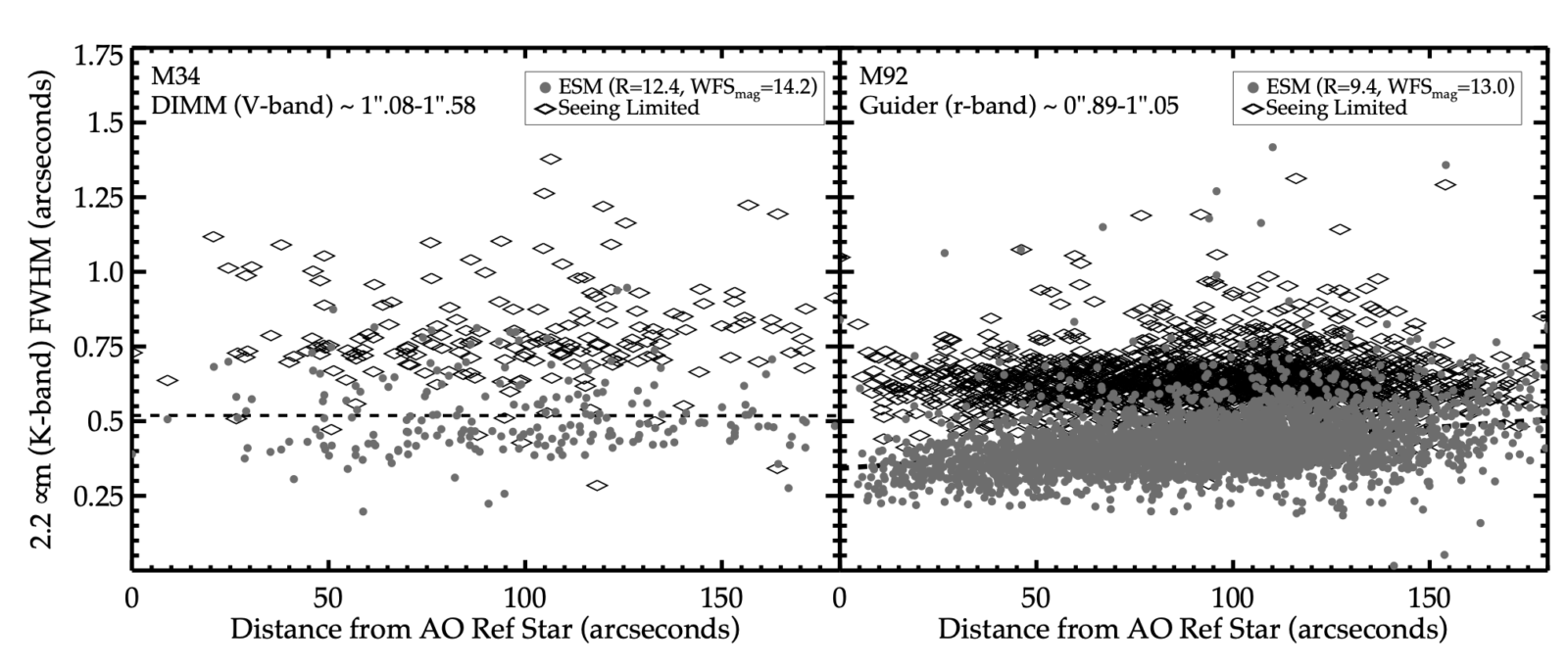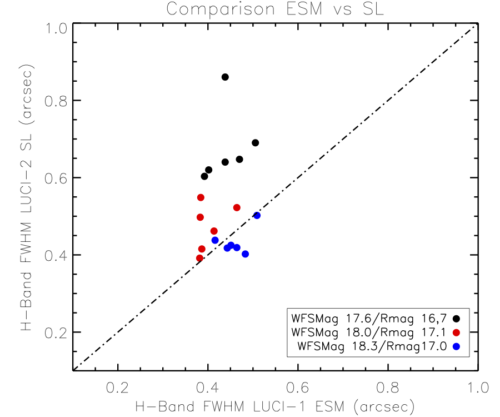Enhanced Seeing Mode (ESM) with LUCI

Shown above are contemporaneous observations of M92 taken with ESM and Seeing Limited Observations. This demonstrates the improved PSF and depth ESM observations can provide in optimal conditions.
Contents
Background:
Enhanced Seeing Mode (ESM) is a mode available as part of the new SOUL (Single counjugated adaptive Optics Upgrade for LBT) upgrade. It was previously available as part of the First Light Adaptive Optics (FLAO) system. The improvements in image quality (IQ) are the same as those provided by FLAO. However, the updated SOUL wavefront system should allow ESM to use fainter reference stars (called AO Ref stars) to determine the corrections to be applied to the adaptive secondary mirrors (ASM). ESM provides 11 modes of corrections, which include: tip+tilt + focus, astigmatism, coma, trefoil, spherical, and one high order. ESM should (almost) always improve the natural seeing conditions, and will not degrade the IQ. As long as there is a suitable AO Ref Star in the AO patrol field (this can be visualized with the Observing Tool) users should consider using ESM for LUCI imaging and spectroscopy.
ESM differs from AO, in two key ways:
- It does not provide diffraction limited corrections, but does improve the point-spread-function (PSF) over seeing limited observations in a variety of conditions.
- It uses the N3.75 camera (0.12″/pixel plate-scale) and can provide corrections over the entire 4′ x 4′ LUCI field of view (FOV).
ESM offers improvements for imaging and spectroscopy. In tests under optimal sky conditions, ESM can deliver an imaging PSF with a full-width at half maximum (FWHM) = 0.22″-0.25″ over the entire FOV. For spectroscopy, ESM provides spatial and spectral improvements and can be used with multi-object slit (MOS) masks (which are not available for use with full-AO). In optimal conditions, ESM will allow users to achieve higher spectral resolution using smaller slitwidths (i.e. 0.25″).
ESM also offers improvements for poor conditions. For imaging, ESM can improve the PSF. For spectroscopy, ESM allows for more light to be focused into larger slits (i.e. 0.5″ or 0.75″) with less slit-loss. Users may wish to use ESM in sub-optimal conditions in order to achieve their original seeing limited science goals. Users may wish to consider using ESM in poor seeing conditions (1.2″ < DIMM < 2″).
Requirements:
ESM has the same setup and scripting requirements as full AO. The overheads for ESM are similar to those for full AO, although the time it takes to close the loop with only 11 modes may be shorter.
- An AO Reference star is required for all observations. This is the star used by the SOUL wavefront sensor to determine the corrections to apply to the ASM. The star must have an Rmag < 16.5 and lie within the AO Reference Star Patrol field shown below. The same AO Ref Star must be used for the entire observation. One cannot switch to another star during an observation. Any dithering (either for imaging or along the slit) must keep the AO Ref Star in the patrol field if the user wishes to have corrections applied at each position.
- For large objects (i.e. galaxy or globular cluster) which require dithers > the LUCI FOV, ESM will pause corrections when the AO Ref Star moves out of the patrol field and resume when the telescope returns to the target field.
- For programs wishing to use their science target as the AO Reference star (this is called On-Axis), please be sure the object has a bright core which is CONFIRMED to be R < 16.5. For example, if you are looking at an R=15 QSO, one should verify the magnitude is not the integrated magnitude (for example, Petrosian or inegrated over a profile – PSF magnitude in SDSS should be OK). Users might want to verify the magnitude with other R-band imaging from SDSS, Pan-Starrs, HST, etc. and measure it in the smallest available aperture. If you are unsure, please contact sciops@lbto.org.
- For large objects (i.e. galaxy or globular cluster) which require dithers > the LUCI FOV, ESM will pause corrections when the AO Ref Star moves out of the patrol field and resume when the telescope returns to the target field.
- LUCI scripts must be generated using the LUCI-AO-ESM-ADI-Library – a seeing limited script cannot be used.
- An off-axis guidestar is required in order to collimate – the guidestar requirements are the same as with seeing limited observations (12 < Rmag < 15.5 and fall within the AGW patrol field shown below). The AO Reference star should not be the same as the off-axis guidestar – this will cause the LUCI FOV to be vignetted.
- The AO Ref Star patrol field is located entirely within the LUCI FOV. Users should consider the brightness and color of the AO Ref Star to avoid saturating the detector and/or the impact of persistence on their science observations.

Figure 1: The AO and AGW patrol fields for both LUCIs.
Planning ESM Observations:
Phase 1 (proposal) and Phase 2 (script preparation) of ESM observations are almost the same as diffraction limited full AO. The major difference is that ESM uses the wide-field N375 camera. Imaging does not require a mask, and spectroscopy can use any MOS or Longslit mask (including the 0″.25 longslit to improve spectral resolution). Below are several additional items to keep in mind for planning ESM observations.
Selecting an AO Reference Star:
Please see the Phase I Planning for Full AO to determine if a viable AO Reference star can be found in your field. The requirements for the AO Reference star and AO patrol field are the same as Full AO. This includes the known discprepancy between the R-band catalog magnitude of a star, and the magnitude “seen” by the SOUL WFS. Empirical measurements show that WFSMag ~ Rmag + 1.2mag. Thus, when selecting a star which is Rmag = 16.5, the WFS should see ~ 17.7 mag. See the section Estimating the Actual WFS Magnitude in the Full AO Planning pages for more information. The performance of ESM at the faintest limits are detailed later on this page.
Vignetting of LUCI N3.75 FOV:
Currently, the bottom part of the LUCI FOV is always vignetted by a platform on the W-unit stage used for AO testing. In seeing limited mode, this impacts the bottom right corner (~70″ x ~22″) in the same way all of the time. However, when the FLAO system is used for ESM, the amount of vignetting depends on where the AO Ref Star is located within the AO patrol field (this is not a problem with diffraction limited AO as only a 30″x30″ FOV is used). This additional vignetting comes from the optics on the wavefront sensor stage. Careful planning is required to reduce the vignetting from the wavefront sensor optics (obscuration from the W-unit stage is always present, even in seeing-limited observations).
Shown below is a comparison of the impact of vignetting. Top left shows a raw ESM K-band image of M51 with more vignetting than normal, bottom left shows the visual planning display from the Observing Tool (OT) corresponding to this exposure. The AO Ref Star is located in the region of the patrol field that causes vignetting. The OT display shows this with a cross-hatched illustration. Top right shows a raw ESM K-band image of M51, but this time the AO Ref Star is outside of the portion of the patrol field susceptible to vignetting (bottom right shows this exposure in the OT display). The further “up” into the hatched region the AO Reference star is, the more of the platform becomes visible at the bottom of the image. At K-band, the stage will usually “glow” (unless the ambient temperature is the same or warmer than the stage). At wavelengths < 2 microns, the stage will be dark.
Figure 2: A comparison of raw K-band data and the vignetting which occurs when the AO Ref Star is in various parts of the patrol field.
ESM Performance:
Currently, there are two use cases for ESM:
- Good-Optimal natural seeing (i.e. <1.2″)
- Mediocre to poor natural seeing (i.e. 1.2″ < seeing < 2″)
Overall Comparison between Poor and Excellent Conditions for ESM:
The plot below shows a comparison of ESM vs seeing limited (SL) K-band data for a field in the star cluster of M34 (left) taken under variable and poor natural seeing, and the NE corner of the globular cluster M92 (taken under good natural seeing conditions). Both are plotted as a function of distance from the AO Ref Star. ESM yields better improvements when turbulence is low in the atmosphere. Currently, LBTO does not have the capability to measure the atmospheric turbulence as a function of height. The results for LUCI-2 are consistent with those shown below for LUCI-1. Note, that FWHM should scale with wavelength (∼λ-1/5), therefore improvements at shorter wavelengths will be less than those measured at K-band (∼2.2μm).

Figure 3: From Rothberg et al. 2020 which provides information about ESM.
Performance at Shorter Wavelengths:
Shown below is an example of the improvement in J-band for ESM observations obtained in poor seeing conditions. The AO Ref star is in the center of the FOV and the target merger galaxy (NGC 3921) is in the SW corner.

Figure 4: LUCI-1 J-band observation of the merger NGC 3921. Observations were taken at an airmass of 1.31. The V-band DIMM (corrected to elevation of the target) FWHM = 1.68″. The ESM observations used an AO Ref Star with R=13.7. The FWHM across the FOV is 0.7″-1.1″.
Faint Limits of ESM:
One of the improvements promised by the SOUL WFS was the ability to use fainter AO Reference stars. In order to quantify the improvements seen, a series of observations were made of faint stars on-axis using ESM with LUCI-1 and simultaneously observing the same stars in seeing limited mode on LUCI-2. The LUCI-2 observations shows what the natural seeing IQ would have been without ESM. The plot below shows the FWHM measured for ESM LUCI-1 and SL LUCI-2. The data are color-coded by the brightness of the AO Reference star (both the catalog Rmag and the WFSmag). The observations were taken under photometric conditions and the data processed in the same way for both LUCIs. Any improvements seen off-axis will also be affected by the distance from the AO Reference star and the atmospheric turbulence. The comparison at K-band should be about the same as the H-band observations below.

Figure 5: Comparison of several stars observed simultaneously with LUCI-1 using ESM and LUCI-2 in SL mode. The dot-dash line is a 1:1 comparison. The data are color-coded by Rmag/WFSmag. Note, the Rmag vs WFSmag discrepancy does vary from 0.9-1.3mag. Observations were obtained under photometric conditions.
Additional Resources:
Preprint for AO4ELT6 Conference – Rothberg et al. 2019
SPIE 2018 Paper – Rothberg et al. 2018 – preliminary results as part of the Facility Instruments Update


